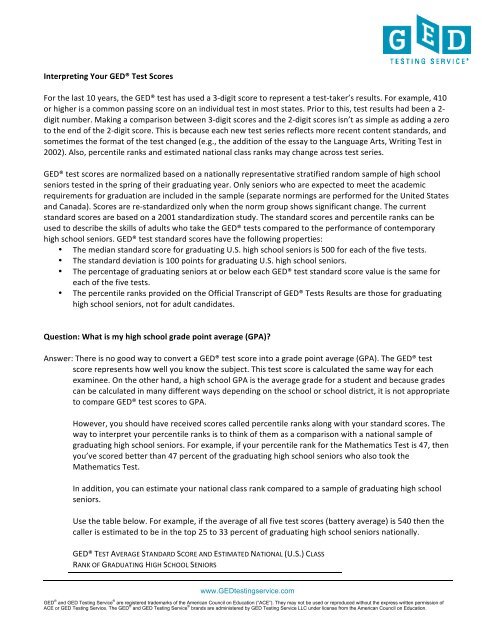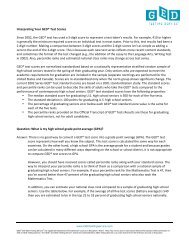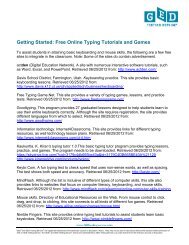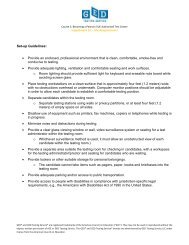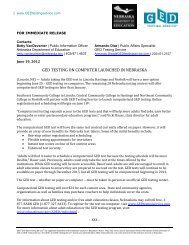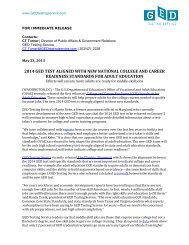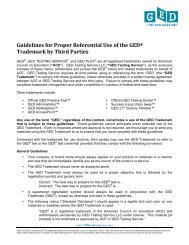Interpreting Your GED® Test Scores For the last 10 years, the GED®
Interpreting Your GED® Test Scores For the last 10 years, the GED®
Interpreting Your GED® Test Scores For the last 10 years, the GED®
Create successful ePaper yourself
Turn your PDF publications into a flip-book with our unique Google optimized e-Paper software.
<strong>Interpreting</strong> <strong>Your</strong> GED® <strong>Test</strong> <strong>Scores</strong> <br />
<strong>For</strong> <strong>the</strong> <strong>last</strong> <strong>10</strong> <strong>years</strong>, <strong>the</strong> GED® test has used a 3-‐digit score to represent a test-‐taker’s results. <strong>For</strong> example, 4<strong>10</strong> <br />
or higher is a common passing score on an individual test in most states. Prior to this, test results had been a 2-‐<br />
digit number. Making a comparison between 3-‐digit scores and <strong>the</strong> 2-‐digit scores isn’t as simple as adding a zero <br />
to <strong>the</strong> end of <strong>the</strong> 2-‐digit score. This is because each new test series reflects more recent content standards, and <br />
sometimes <strong>the</strong> format of <strong>the</strong> test changed (e.g., <strong>the</strong> addition of <strong>the</strong> essay to <strong>the</strong> Language Arts, Writing <strong>Test</strong> in <br />
2002). Also, percentile ranks and estimated national class ranks may change across test series. <br />
GED® test scores are normalized based on a nationally representative stratified random sample of high school <br />
seniors tested in <strong>the</strong> spring of <strong>the</strong>ir graduating year. Only seniors who are expected to meet <strong>the</strong> academic <br />
requirements for graduation are included in <strong>the</strong> sample (separate normings are performed for <strong>the</strong> United States <br />
and Canada). <strong>Scores</strong> are re-‐standardized only when <strong>the</strong> norm group shows significant change. The current <br />
standard scores are based on a 2001 standardization study. The standard scores and percentile ranks can be <br />
used to describe <strong>the</strong> skills of adults who take <strong>the</strong> GED® tests compared to <strong>the</strong> performance of contemporary <br />
high school seniors. GED® test standard scores have <strong>the</strong> following properties: <br />
• The median standard score for graduating U.S. high school seniors is 500 for each of <strong>the</strong> five tests. <br />
• The standard deviation is <strong>10</strong>0 points for graduating U.S. high school seniors. <br />
• The percentage of graduating seniors at or below each GED® test standard score value is <strong>the</strong> same for <br />
each of <strong>the</strong> five tests. <br />
• The percentile ranks provided on <strong>the</strong> Official Transcript of GED® <strong>Test</strong>s Results are those for graduating <br />
high school seniors, not for adult candidates. <br />
Question: What is my high school grade point average (GPA) <br />
Answer: There is no good way to convert a GED® test score into a grade point average (GPA). The GED® test <br />
score represents how well you know <strong>the</strong> subject. This test score is calculated <strong>the</strong> same way for each <br />
examinee. On <strong>the</strong> o<strong>the</strong>r hand, a high school GPA is <strong>the</strong> average grade for a student and because grades <br />
can be calculated in many different ways depending on <strong>the</strong> school or school district, it is not appropriate <br />
to compare GED® test scores to GPA. <br />
However, you should have received scores called percentile ranks along with your standard scores. The <br />
way to interpret your percentile ranks is to think of <strong>the</strong>m as a comparison with a national sample of <br />
graduating high school seniors. <strong>For</strong> example, if your percentile rank for <strong>the</strong> Ma<strong>the</strong>matics <strong>Test</strong> is 47, <strong>the</strong>n <br />
you’ve scored better than 47 percent of <strong>the</strong> graduating high school seniors who also took <strong>the</strong> <br />
Ma<strong>the</strong>matics <strong>Test</strong>. <br />
In addition, you can estimate your national class rank compared to a sample of graduating high school <br />
seniors. <br />
Use <strong>the</strong> table below. <strong>For</strong> example, if <strong>the</strong> average of all five test scores (battery average) is 540 <strong>the</strong>n <strong>the</strong> <br />
caller is estimated to be in <strong>the</strong> top 25 to 33 percent of graduating high school seniors nationally. <br />
GED® TEST AVERAGE STANDARD SCORE AND ESTIMATED NATIONAL (U.S.) CLASS <br />
RANK OF GRADUATING HIGH SCHOOL SENIORS <br />
www.GEDtestingservice.com<br />
GED ® and GED <strong>Test</strong>ing Service ® are registered trademarks of <strong>the</strong> American Council on Education (“ACE”). They may not be used or reproduced without <strong>the</strong> express written permission of<br />
ACE or GED <strong>Test</strong>ing Service. The GED ® and GED <strong>Test</strong>ing Service ® brands are administered by GED <strong>Test</strong>ing Service LLC under license from <strong>the</strong> American Council on Education.
Battery Average <br />
Standard Score <br />
Estimated National Class Rank <br />
700 Top 1% <br />
670 Top 2% <br />
660 Top 3% <br />
640 Top 5% <br />
6<strong>10</strong> Top <strong>10</strong>% <br />
580 Top 15% <br />
570 Top 20% <br />
550 Top 25% <br />
530 Top 33% <br />
520 Top 40% <br />
500 Top 50% <br />
460 Top 55% <br />
450 Top 60% <br />
Source: College Admissions and Candidates with GED® High School <br />
Credential, GED <strong>Test</strong>ing Service brochure, 2003. <br />
GED <strong>Test</strong>ing Service ® | www.GEDtestingservice.com 2


